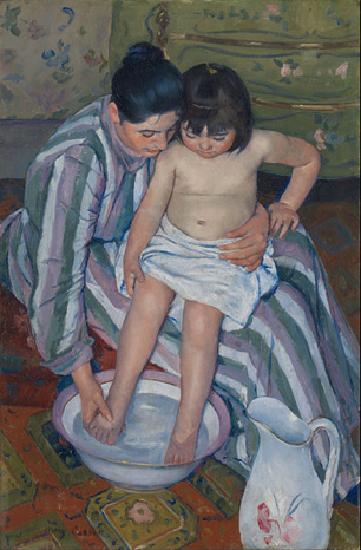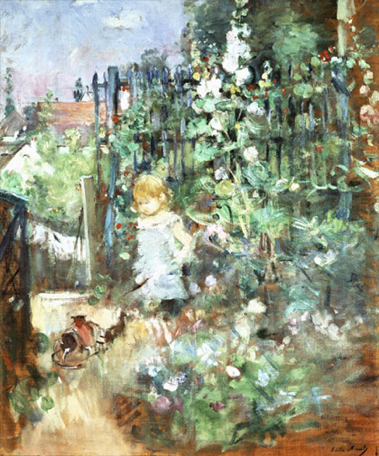11.7: Impressionism (1860 – 1890)
- Page ID
- 31940
Impressionism was an art movement from 1860 to 1886; nevertheless, in that short time, it completely changed art forever. Until the 1860s, Romanticism and Realism, with the photo-like quality of painting, controlled the art world. Impressionists ultimately rejected all known art styles and began to paint with awareness, stylistic abandonment, and captured brief glimpses of a moment in time, and painted en Plein aire. Earlier in the 19th century, the tin tube was invented, freeing the artists to carry multiple colors of paint to a site and using broad brushstrokes, capture the light, intensity, and hues of natural environments.
Impressionism received its name one day when a newspaper writer wrote a review of the first Société Anonyme des Artistes. He was viewing Claude Monet's painting, Impression Sunrise (11.27), and called the article "Exhibition of the Impressionist." At first, the name was sarcastic, but it stuck; the style and artists associated with the techniques are called Impressionists.
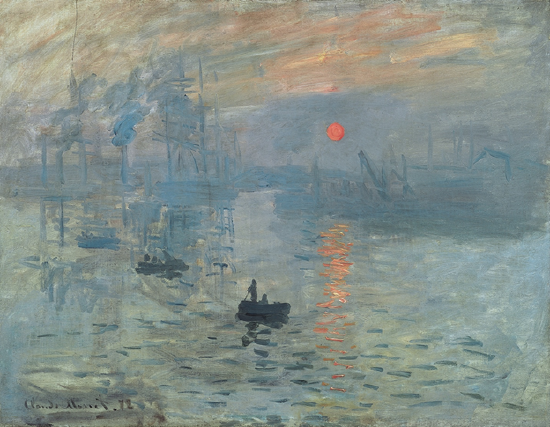
Claude Monet (1840-1926) was one of the most consistent and prolific painters of the Impressionist period. Using paint freely on the canvas and using intense pure color is characteristic of impressionism. The artists also painted outside to capture the fleeting light. Monet frequently painted a series from the same position to demonstrate how the changing light affected the appearance and impression of the painting. He went to Venice, painting six images of the Grand Canal. In Grand Canal Venice (11.28) and The Grand Canal (11.29), the two paintings demonstrate how light changes the colors, depth of the shadows, and mood of the location.


Monet bought several acres of land with a house in Giverny, France, transforming the area into a masterpiece garden setting. The garden, dominated by archways, roses, flower beds, and the water lily pond and bridge, became the centerpiece of a large number of his paintings, the most well-known based of the water lilies. The Water Lilies and Japanese Bridge (11.30) represent the pond with cool greens, reflective water, and the iconic Japanese footbridge. He generally set up multiple canvases around the pond and painted at different times of the day. The water in Waterlilies(11.31) reflects the bright sunlight of the day, individual lily pads floating on the surface with delicate flowers. In The Water Lily Pond (11.32), the reflective sun is limited to the side of the painting. The rest of the pond rests in shadows from the trees, and the lily pads show differing in light or shadows.
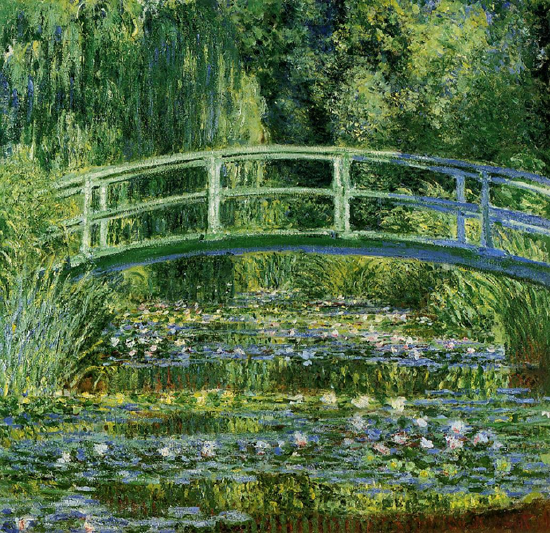
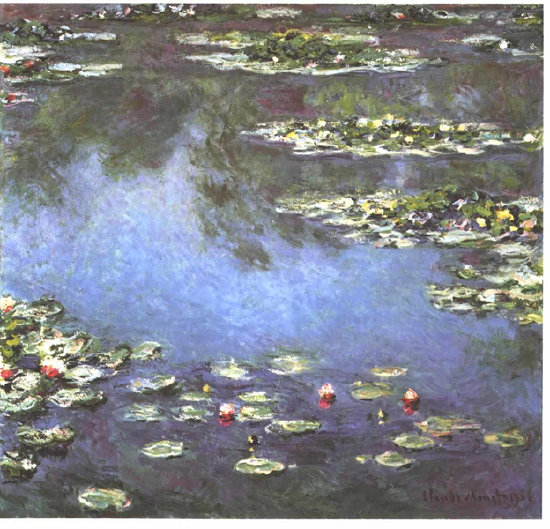
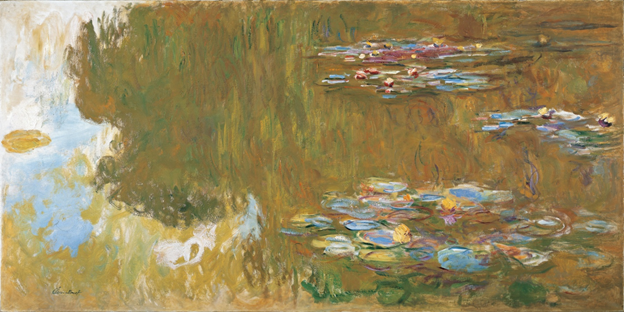
Auguste Renoir (1841-1919) attended art school in Paris with many of the artists, including Monet, who embraced the new ideas of painting. Renoir relished the renaissance artists yet loved the painting style of the impressionists. On Sundays, the working people went to the cafes to eat, drink and dance. Renoir captured the scene in Le Moulin de la Galette (11.33), painted with fluid brushstrokes to create the dappled sunlight reflecting on the exuberant dancers. The painting is a snapshot of ordinary life, which is the theme of the Impressionists. The painting was accepted into a Salon, advancing his credibility as an artist. Renoir frequently sat along the Seine, painting scenes of people engaged in ordinary activities. The two sisters in Two Sisters (On the Terrace) (11.34) are sitting by the river with a basket filled with balls of wool. The trees and rivers painted in loose, broad brushstrokes in muted colors and the two girls dominate the foreground with intense, contrasting colors of white, blue, and red.
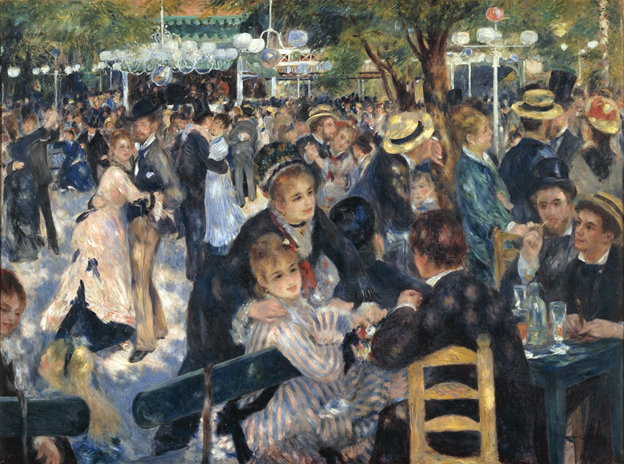
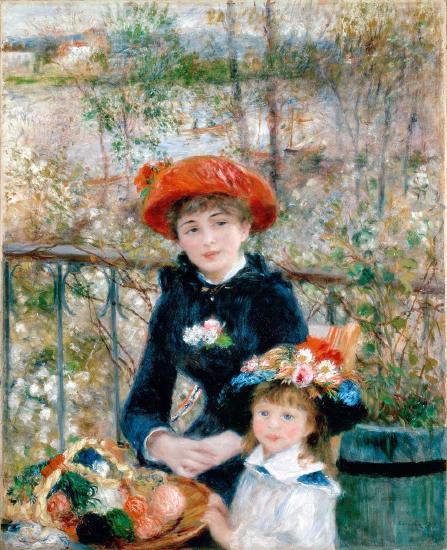
Painting en Plein air, Alfred Sisley (1839-1899) spent most of his life in France painting outdoors, capturing the shimmering water, clouds floating by, and people engaged in outdoor activities. Camille Pissarro (1830-1903) was born in the Danish West Indies, which had a timeless influence on his art because of the different ways light and color existed in the islands. Comparing their two paintings, The Bridge at Villeneuve-la-Garenne (11.35), by Sisley illustrates the bright light reflecting in the blue sky and water, the green trees defining the time like summer. The Red Roofs (11.36) by Pissarro has deeper reds on the roofs and shrubs. The sky is darker, the light muted, the bare trees indicating winter. Both paintings represent the moment in time the Impressionists pursued, caught in a landscape of the French countryside.
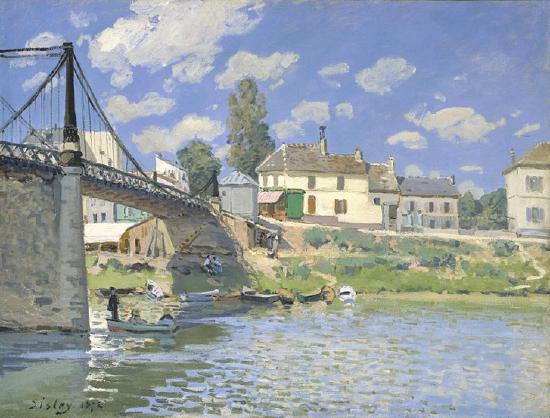
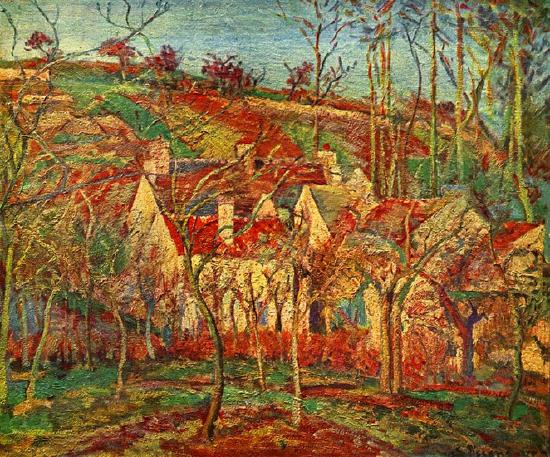
Three women contributed to the Impressionism period with their styles and paintings. Mary Cassatt (1844-1926), Berthe Morisot (1841-1895), and Marie Bracquemond (1840-1916) considered the 'Grand Dames of the Impressionists'. Morisot and Bracquemond were native to France, and Cassatt was born in America, moving to France for art school. Their styles were all similar and focused on women, children and nature, everyday life, and shared activities. The viewers of the work captivate the viewer with the use of free brushwork up close and standing far away. All three women were master painters, and if they were men, they might have been considered the top three artists of the Impressionism period.
Mary Cassatt mostly created paintings or prints of the private lives of women and their children. The close-cropped scenes have an emphasis on the intimate bonds that only a mother and child can have, as seen in The Child's Bath (11.37). Cassatt used simple muted colors to portray the ordinary scene, one not found in paintings by men. Morisot's Child Among the Hollyhocks (11.38) shows a child exploring the flowers. She liberally used loose brushstrokes of white paint to bring accents and movement to the painting. Bracquemond's scene in Artist's Son and Sister in the Garden at Sevres(11.39) is also a simple setting, but the use of color brings the subjects to life. Women seldom painted in public spaces or landscapes, their work generally confined to gardens or spaces in their homes or neighborhoods.
